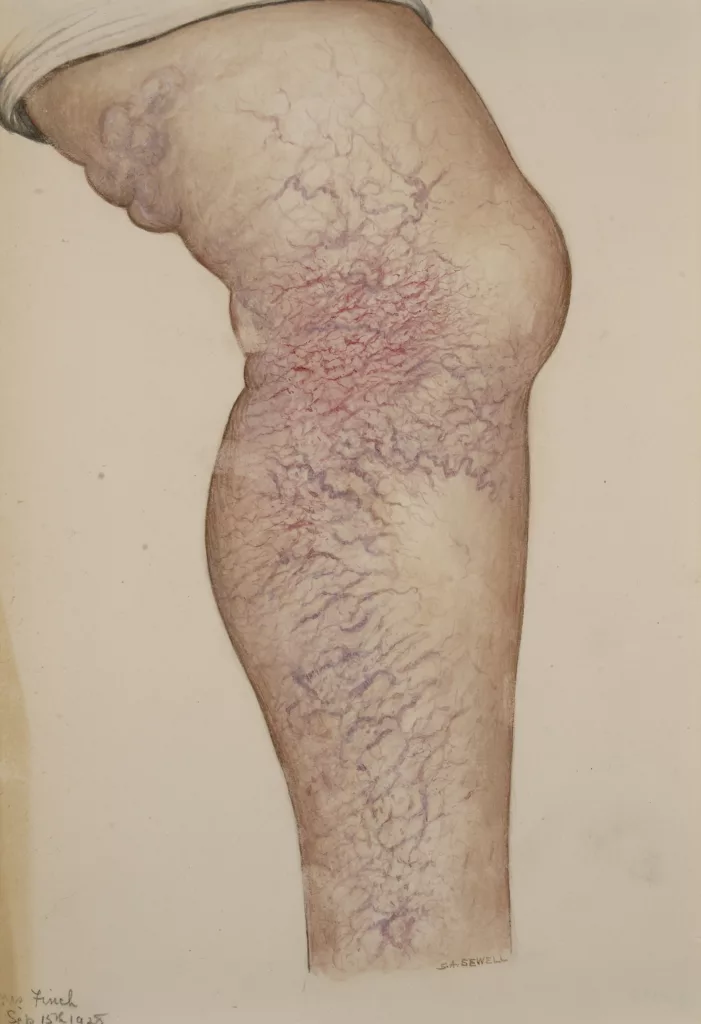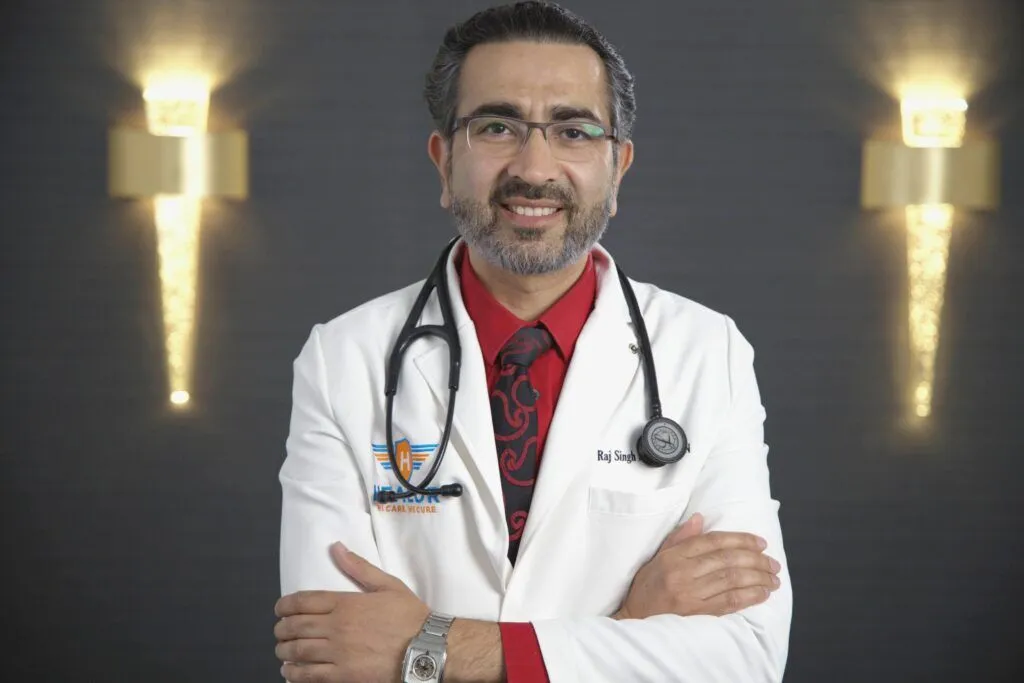
While most veins are hidden from sight, some individuals may notice unsightly veins appearing on their legs. These visible veins can range from small spider veins to more prominent varicose veins, often making people conscious about the appearance of their legs.
In this comprehensive guide, we’ll reveal the causes of prominent leg veins and how this is treated in the dermatologist’s office. We’ll also provide some tips to prevent them from appearing.
What Causes Veins To Show on Legs?
Veins are blood vessels responsible for transporting deoxygenated blood back to the heart. Unlike arteries with muscular walls to pump blood, veins rely on one-way valves to prevent blood from flowing backward.
When these valves weaken or malfunction, blood can pool in the veins, causing them to enlarge and become visible. Several factors contribute to the development of visible leg veins, such as:
- Genetics: Genetics can play a significant role in whether you’ll develop visible leg veins.
- Age: As we age, the elasticity of our veins decreases, making it more difficult for them to maintain their shape.
- Gender: Hormonal changes associated with pregnancy, menstruation, and hormone replacement therapy can weaken vein walls, making them more susceptible to enlargement.
- Pregnancy: The increased blood volume during pregnancy and the pressure exerted by the growing uterus can lead to the development of varicose veins.
- Prolonged Standing or Sitting: Jobs requiring long standing or sitting periods can hinder blood circulation in the legs, increasing the risk of visible veins.
Is It Normal To Have Big Veins in Your Legs?
The visibility of leg veins varies from person to person. Some individuals have naturally larger or more prominent veins due to genetic factors.
However, when discussing “big veins” in the context of varicose or spider veins, it’s important to note that they are typically not considered normal.
- Varicose veins are swollen, twisted veins that can be painful and cause discomfort. They often appear bluish or purplish and are commonly seen on the legs, especially in the calf and thigh areas.
- Spider veins are smaller, red or blue veins resembling a spider’s web. They are usually not painful but can be cosmetically bothersome to some people.
How Do Dermatologists Treat Varicose or Spider Veins?
Visible leg veins, whether they are varicose or spider veins, can be a source of discomfort and self-consciousness for many individuals. Fortunately, dermatologists offer various treatment options to address these concerns.
Sclerotherapy
A popular treatment for spider veins and minor varicose veins is sclerotherapy. This minimally invasive procedure involves the injection of sclerosant directly into the affected veins. This solution irritates the lining of the veins, collapses them, and sticks them together.
Sclerotherapy is a straightforward outpatient procedure that typically requires little to no downtime. Multiple sessions may be necessary for complete vein disappearance, depending on the extent of the issue.
Laser Vein Treatment
Endovenous laser therapy (EVLT) or laser vein therapy is a non-invasive method to target and eliminate spider and smaller varicose veins. A specialized laser delivers intense bursts of light energy into the veins during the procedure. This energy is absorbed by the blood vessels, causing them to heat up and eventually collapse.
Laser vein treatment is a well-tolerated procedure with minimal discomfort and a short recovery time. Some individuals may experience mild bruising or redness at the treatment site, but this typically resolves within a few days.
Radiofrequency Ablation
Radiofrequency ablation (RFA) is an effective treatment option for more prominent varicose veins. It involves using radiofrequency energy to heat and seal the affected vein. A thin catheter is inserted into the vein under ultrasound guidance, and radiofrequency energy is applied, causing the vein to close.
RFA is a minimally invasive procedure that is performed on an outpatient basis. Patients can usually return to their normal activities shortly after the procedure.
Ligation and Stripping
Ligation and stripping are surgical procedures that may be recommended for individuals with severe varicose veins. These procedures are more invasive and involve physically removing the damaged vein.
The affected vein is tied off or ligated during ligation to prevent blood flow. Dermatologists often use this process with stripping, where a thin, flexible wire or catheter is inserted into the vein through small incisions to remove the damaged vein from the leg.
Phlebectomy
Phlebectomy is a minimally invasive surgical procedure that removes varicose veins close to the skin’s surface. Specialists often recommend phlebectomy for medium-sized varicose veins unsuitable for other treatments like sclerotherapy or RFA.
During phlebectomy, dermatologists make tiny incisions in the skin and remove the damaged vein. The procedure is performed under local anesthesia and typically leaves only tiny scars.
What Lifestyle Changes Can You Make To Minimize Varicose Veins?
While medical treatments effectively address visible leg veins, certain lifestyle changes can help minimize their development and prevent recurrence. Here are some tips to consider:
- Maintain a Healthy Weight: Losing excess weight can reduce the pressure on your leg veins, lowering the risk of varicose veins.
- Stay Active: Regular physical activity, such as walking or swimming, promotes healthy blood circulation in the legs.
- Elevate Your Legs: When resting or sleeping, place a pillow or supporter under your legs to help blood flow back to the heart and reduce vein pressure.
- Avoid Prolonged Standing or Sitting: If your job requires long periods of standing or sitting, take breaks to move and stretch your legs.
- Wear Compression Stockings: Compression stockings apply gentle pressure to the legs, helping to prevent blood from pooling in the veins.
Get Your Varicose Vein Treated Today
Visible leg veins, whether varicose or spider veins, can impact your confidence and comfort. Fortunately, numerous treatment options are available to address these concerns, ranging from minimally invasive procedures like sclerotherapy and laser therapy to surgical interventions when necessary.
If you’re troubled by the appearance or discomfort of your leg veins, don’t hesitate to seek medical advice. A dermatologist can assess your condition, recommend the most suitable treatment plan, and guide lifestyle changes to maintain healthy veins.
With the right approach, you can regain confidence in your legs and enjoy improved circulatory health. Get your varicose veins treated today for a brighter, more comfortable future.

